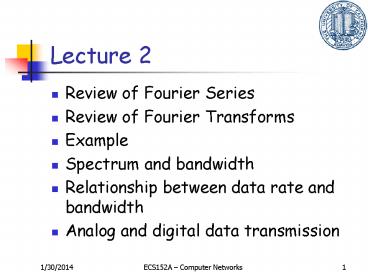Review of Fourier Series - PowerPoint PPT Presentation
1 / 23
Title:
Review of Fourier Series
Description:
Pj = power through the first j harmonics = (1/4) C02 (1/2) n=1 ... High degree of multiplexing easier with digital techniques. Security & Privacy. Encryption ... – PowerPoint PPT presentation
Number of Views:66
Avg rating:3.0/5.0
Title: Review of Fourier Series
1
Lecture 2
- Review of Fourier Series
- Review of Fourier Transforms
- Example
- Spectrum and bandwidth
- Relationship between data rate and bandwidth
- Analog and digital data transmission
2
Spectrum Bandwidth
- Spectrum
- range of frequencies contained in signal
- Examples
- (1) for s(t) sin(2?f1t) 1/3 sin(2p(3f1)t) the
spectrum is from f1 to 3f1 - (2) for s(t) square wave of time period T
(1/f) the spectrum is f to ? - Absolute bandwidth
- width of spectrum
- Examples
- (1) absolute bandwidth is 2f1
- (2) absolute bandwidth is ?
3
Spectrum Bandwidth
- Effective bandwidth
- Often just bandwidth
- band of frequencies containing most of the energy
- DC Component
- Component of zero frequency
4
Power Spectrum
- The function s(t) specifies the signal in terms
of voltage or current - The average power of a time limited signal is
given by - P (1/t2 - t1) ?t1-gtt2 x(t)2 dt
- For periodic signal the average power in one
period (T) is given by - P (1/T) ?0-gtT x(t)2 dt
5
Power Spectrum
- We would like to know the signal power as a
function of the frequency -- power spectral
density - For periodic signals the power spectrum is
discrete - Pj power through the first j harmonics
- (1/4) C02 (1/2) ?n1 -gtj cn2
- For aperiodic signal the power spectrum is
continuous - P power contained in a band of frequencies f1
and f2 2 ?f1 -gt f2 S(f) df
6
Power Spectrum
- Half-power bandwidth
- Range of frequencies at which S(f) has dropped to
half of its maximum value of power - Pasevals Power Theorem
- The normalized value of the mean power of a
periodic signal is equal to the sum of squared
amplitudes of all harmonic components of signal
s(t).
7
Relationship Between Data Rate and Bandwidth
- Just like the signal has a bandwidth, any
transmission system has a bandwidth - the transmission medium accommodates a limited
band of frequencies - This limits the data rate that can be carried
- Consider a periodic square wave s(t) of period T
- Using Fourier series the square wave can be
expressed as - s(t) (4?/k) ? n odd n1 -gt ? (1/n)sin(2?nf1t)
- where f11/T is the period of the signal
8
Relationship Between Data Rate and Bandwidth
- This waveform has infinite number of harmonics
and hence infinite bandwidth - The peak amplitude of the kth component is 1/k
that of the fundamental frequency - Most of the power will be concentrated in the
first few harmonics
9
Case 1
- Let us consider that the square wave is very well
approximated by the first three harmonics. I.e., - s(t) 4/p (sin 2pft 1/3 sin 2p 3f t 1/5 sin
2p 5f t)
10
signal noise
signal
noise
Figure 3.12
11
Signal to Noise Ratio
signal noise
signal
noise
Figure 3.12
12
Analog and Digital Data Transmission
- Data
- Entities that convey meaning
- Signals
- Electric or electromagnetic representations of
data - Transmission
- Communication of data by propagation and
processing of signals
13
Data
- Analog
- Continuous values within some interval
- e.g. sound, video
- Digital
- Discrete values
- e.g. text, integers
14
Analog (Stream) Date
- Voice, video occur in steady stream
- The data can take continuous values
15
Block (Digital) Data
- Examples
- Text files
- Scanned color documents
Figure 3.1
16
Video Data
_at_ 30 frames/sec 10.4 x 106 pixels/sec
_at_ 30 frames/sec 67 x 106 pixels/sec
17
Converting Analog Data to Digital Data
- Sampling
- What should be the sampling rate?
- Nyquist rate Twice the maximum bandwidth of the
signal - Digitize the sample
- Quantization error
18
Transmission Medium
- Type
- Guided medium - e.g. twisted pair, optical fiber
- Unguided medium - e.g. air, water, vacuum
- Characteristic
- Simplex
- signal is transmitted in only one direction
- Half-duplex
- both station may transmit but only one at a time
- Full-duplex
- both stations may transmit simultaneously. The
medium is carrying signals in both directions.
19
Analog and Digital Transmission
- (a) Analog transmission all details must be
reproduced accurately
- e.g. AM, FM, TV transmission
(b) Digital transmission only discrete levels
need to be reproduced
20
A Generic Long-Distance Link
- Over distance
- Signal is attenuated
- Noise (thermal and electromagnetic) noise gets
added. - Repeaters regenerate signal
Figure 3.7
21
An Analog Repeater
- Amplify the signal
- Eliminate distortion using the equilizer
- Different frequency components are
- Attenuated differently
- Delayed differently
- Noise accumulates
22
A Digital Repeater
- Amplifier and equalizer mitigate some of the
channel distortion - Goal is not to regenerate the signal but to
determine the original pulse - Regenerate a fresh pulse
- Noise does not accumulate
23
Advantages of Digital Transmission
- Digital technology
- Low cost LSI/VLSI technology
- Data integrity
- Longer distances over lower quality lines
- Capacity utilization
- High bandwidth links economical
- High degree of multiplexing easier with digital
techniques - Security Privacy
- Encryption
- Integration
- Can treat analog and digital data similarly































